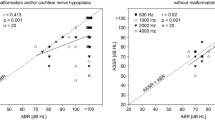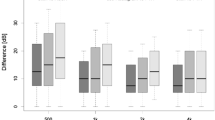Abstract
Background
Click auditory brainstem response (ABR), is abrupt and rapid onset, have broad spectrum nonfrequency-specific response. ABR needs good neural synchrony, the greater number of neurons that fire results in a larger response amplitude. The application of chirp stimuli aims to produce a synchronized response from a large portion of hair cells in the basilar membrane. The chirp was designed to produce simultaneous displacement maxima along the cochlear partition by compensating for frequency-dependent traveling-time differences.
Objectives
The aim of this study was to correlate between pure-tone audiometry (PTA) threshold and click and chirp-ABR thresholds in children with moderate and severe sensory neural hearing loss.
Patients and methods
This study included two groups: control group (G1), which consisted of 30 children with normal peripheral hearing and study group (G2), which consisted of 60 children with moderately severe sensorineural hearing loss (SNHL).
Results
Results showed that significant correlation between chirp and behavioral PTA and between click and behavioral PTA in normal hearing and hearing-impaired children, except in severe steeping SNHL. In steeping SNHL, there was a reduced correlation between behavioral PTA and click ABR stimuli. In addition, there was a significant correlation between narrow band-chirp at 500, 1000, and 4000 Hz and behavioral PTA in normal hearing and sensory neural hearing loss in children, otherwise in severe steeping SNHL. In this category, there was a reduced the correlation between behavioral PTA and narrow band-chirp-ABR stimuli.
Article PDF
Similar content being viewed by others
References
Michael E, Glassock M III, Gary Jackson C, Anne Forrest Josey M. The ABR handbook. Auditory Brainstem Response; 2nd edition; 1987.
Cebulla M, Sturzebecher E, Elbering C, Muller J. New clicklike stimuli for hearing testing. J Am Acad Audiol 2007; 18:725–738.
Elberling C, Don M, Cebulla M, Stürzebecher E. Auditory steady-state responses to chirp stimuli based on cochlear traveling wave delay. J Acoust Soc Am 2007; 122:2772–2785.
Cebulla M, Lurz H, Shehata-Dieler W. Evaluation of waveform, latency and amplitude values of chirp ABR in newborns. Int J Pediatr Otorhinolarynol 2014; 78:631–636.
van der Drift J, Brocaar M, van Zanten G. The relation between the pure-tone audiogram and the click auditory brainstem response threshold in cochlear hearing loss. Audiology 1987; 26:1–10.
Rodrigues G, Lewis D. Comparison of click and CE-chirp® stimuli on brainstem auditory evoked potential recording. Rev Soc Bras Fonoaudiol 2012; 17:412–416.
Maloff E, Hood L. A comparison of auditory brain stem responses elicited by click and chirp stimuli in adults with normal hearing and sensory hearing loss. Ear Hear 2014; 35:271–282.
Hall J. New handbook S of S auditory S evoked S responses F [ISBN 0-205- 36104–8. OCLC. 71369649]. Boston, MA: Pearson 2007.
Stapells D, Picton T, Durieux-Smith A. Electrophysiological measures of frequencies specific auditory function. In Jacobson JT (ed.). Principles and applications in auditory evoked potentials Needham Heights, MA: Allyn and Bacon 1994; 251–283
Xu Z, Cheng W, Yao Z. Prediction of frequency-specific hearing threshold using chirp auditory brainstem response in infants with hearing losses. Inter J Ped Otolaryng 2014; 78: 812–816.
Elberling C, Don M. Auditory brainstem responses to a chirp stimulus designed from derived-band latencies in normal-hearing subjects. J Acoust Soc Am 2008; 124:3022–3037.
Author information
Authors and Affiliations
Corresponding author
Additional information
This is an open access journal, and articles are distributed under the terms of the Creative Commons Attribution-NonCommercial-ShareAlike 4.0 License, which allows others to remix, tweak, and build upon the work non-commercially, as long as appropriate credit is given and the new creations are licensed under the identical terms.
Financial support and sponsorship
Nil.
Conflicts of interest
There are no conflicts of interest.
Rights and permissions
This article is licensed under a Creative Commons Attribution 4.0 International License, which permits use, sharing, adaptation, distribution and reproduction in any medium or format, as long as you give appropriate credit to the original author(s) and the source, provide a link to the Creative Commons licence, and indicate if changes were made. The images or other third party material in this article are included in the article's Creative Commons licence, unless indicated otherwise in a credit line to the material. If material is not included in the article's Creative Commons licence and your intended use is not permitted by statutory regulation or exceeds the permitted use, you will need to obtain permission directly from the copyright holder. To view a copy of this licence, visit http://creativecommons.org/licenses/by/4.0/.
About this article
Cite this article
Hoda, AM., Sayed, E. & Mahran, S. Auditory brainstem response to chirp stimulus in children with moderate and severe sensorineural hearing loss. Egypt J Otolaryngol 35, 322–326 (2019). https://doi.org/10.4103/ejo.ejo_25_18
Received:
Accepted:
Published:
Issue Date:
DOI: https://doi.org/10.4103/ejo.ejo_25_18




